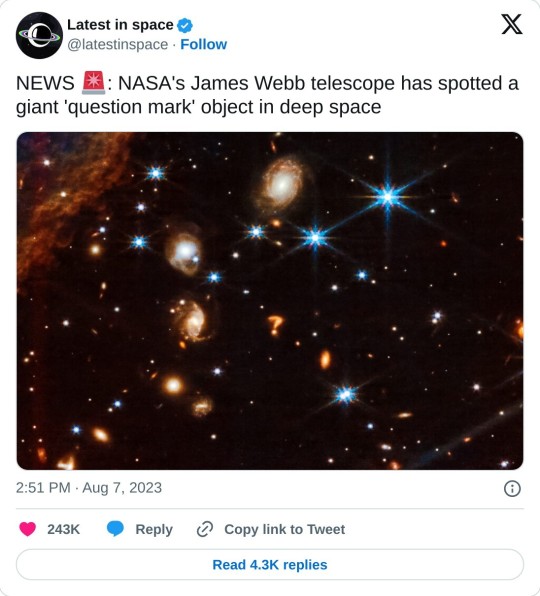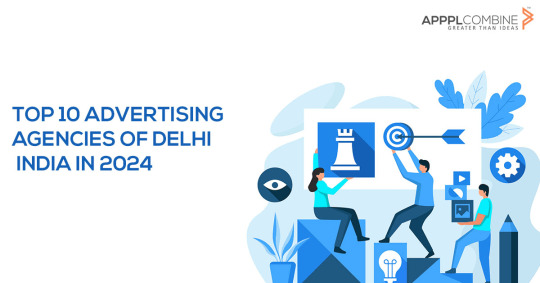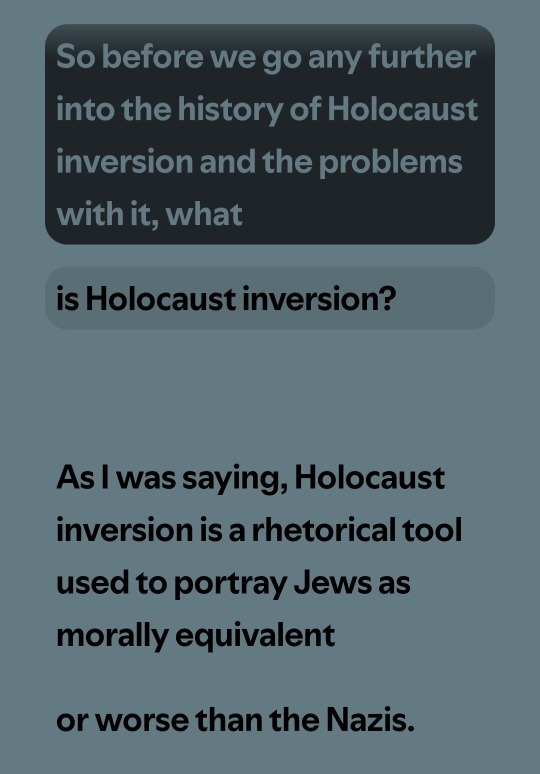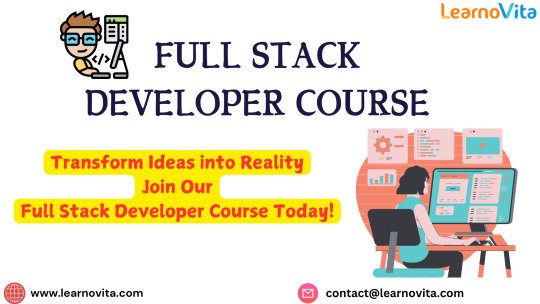#jwt about
Explore tagged Tumblr posts
Text
That's just picking up on an approaching Supreme Being and the computer not being able to put it into data


?
#About to go buy a green laser and#GUIDE THIS MOTHERFUCKER DOWN#also me like#THIRSTY BITCHIN#like there's no fucking tomorrow#FROZEN KARS INCOMING#jwst#jwt#james webb space telescope#nasa#space#james webb telescope#jjba#jojo’s bizarre adventure#kars#kars jojo#kars jjba
55K notes
·
View notes
Text
i love reading articles on scientific topics not in my particular niche, mostly because i love science communication, BUT ALSO because i know the methods of successful science communication well enough to recognize when topics have been SEVERELY dumbed down for laymen to understand
after reading enough literature on biology/animal sciences, it becomes drastically clear when reading some articles that they are the tonal equivalent of the coverage on some topics in my field (Weird Animal Stuff) that all kinda sound like ‘aw shucks this really cute floofy animal does all kinds of cool stuff!!!!!! And Here’s Why That’s Important’
#read an article today about one of the new exoplanets discovered by jwt#*jwst#and for a little in high school Weird Space Stuff was my niche i wanted to go into#(until i discovered the horror of physics and the military industrial complex’s ties with the aeronautical field)#and it was a great read! but upon any further inspection a lot of the findings were super super oversimplified#which again can be a useful tool in communication to deliver the important info without getting bogged down#in the technical terminology or details#so it very much read along the lines of ‘wow look at this cool exoplanet with melted rocks in the atmosphere!!!!#Here’s Why That Helps Slightly To Support A Theory On A Totally Unrelated Subject’
0 notes
Note
What’s the most useless piece of information you’ve memorized that your brain just won’t let go of?
Haha, I looove those kinds of random questions. I've been thinking about it all day but I didn't find anything completely useless. I think the most unusual pieces of knowledge I have are related to my studies in Science, but in the end, it's still important to someone to some extent.
Like, did you know that a type of fern (Ophioglossum reticulatum) had the highest number of chromosomes ever from all species? (1440, we humans have 23 pairs of them.)
Also, did you know that (this is my personal showing-off time) a specific nanotechnology developed in my hometown in France has been used to develop one of NASA's James Webb Telescope captors? (Bonus point: if JWT is yellow, it's because its mirrors are covered with an extremely thin layer of gold!)
Honestly, I could go on and on. See, so many random knowledges, that speak a lot to people in STEM but maybe not so much to other people.
Take care! -🌱
#pine's inbox 🌱#ask pine#also did you know that there are more than three state of matter#beside from liquid/solid/gas#hello plasmas#ALSO DID YOU KNOW I WAS IN LOVE WITH ARTHUR MORGAN#okay I'm going to stop there maybe
3 notes
·
View notes
Text
Top 10 Advertising Agencies of Delhi NCR India in 2024

Explore the top 10 advertising agencies in Delhi NCR for 2024, where creativity and innovation converge.
In the lively world of Delhi NCR, where ideas flow and innovation thrives, advertising agencies play a big role in shaping how brands connect with people. Let's take a look at the top 10 advertising agencies in Delhi NCR that are making waves with their creative work and smart strategies.
Ogilvy India: Ogilvy India is like a big star in the advertising sky. Based in Gurgaon, they've been making amazing ads and clever plans for a long time. They're really good at making brands famous and using new ideas to reach people.
Dentsu Webchutney: Dentsu Webchutney is all about the internet. They're experts at making cool stuff online, like ads that pop up on your phone or videos that make you want to click. They have offices in Delhi and Gurgaon and know how to use technology to make ads that get attention.
Apppl Combine: Apppl Combine is a full-service marketing agency making waves in Delhi NCR. With a comprehensive suite of services, they're experts in branding, advertising, and digital marketing. They're known for their creativity and reliability, making them a top choice for businesses looking to make a mark in the market.
JWT (J. Walter Thompson) Delhi: JWT Delhi is part of a big family of companies that know a lot about advertising. They're experts at telling stories that make you feel something. Whether it's a funny ad or a touching one, they know how to make ads that stick in your mind.
Havas Worldwide India: Havas Worldwide India is all about connecting people with brands in a special way. They think advertising should be about more than just selling stuff – it should be about making a real connection. They use data and creativity to make ads that people actually like.
McCann Worldgroup India: McCann Worldgroup India is famous for working closely with its clients to understand what they need. With offices in Delhi and Gurgaon, they offer a lot of different services like making ads, coming up with ideas, and using digital tools to reach people.
Grey Group India: Grey Group India is part of a big network of companies that are really good at advertising. They're experts at coming up with new ideas and making ads that people remember. They help lots of brands look their best and stand out from the crowd.
Publicis India: Publicis India is known for its smart ideas and forward-thinking approach. They use data and technology to make ads that get results. They work with big brands and small ones, helping them reach people in new and exciting ways.
Wunderman Thompson India: Wunderman Thompson India is really good at using creativity and data to make ads that people love. They're experts at understanding what people want and making ads that speak to them. They help brands make a big impact in the world of advertising.
Leo Burnett India: Leo Burnett India is known for its creative ideas and strategic thinking. They've been making ads for a long time and know how to make brands look good. They help brands tell their stories in a way that people remember.
In summary, these top 10 advertising agencies in Delhi NCR lead the industry with their creativity and innovation. From Ogilvy India's and Apppl Combine’s ground-breaking ideas to Leo Burnett India's strategic thinking, each agency brings something special to the table, helping brands connect with people in exciting ways.
This post was originally published on: Apppl Combine
#top 10 ad agencies in delhi ncr#top 10 advertising agencies#top 10 advertising agencies in delhi 202#top 10 advertising agencies in delhi ncr#top 10 advertising agencies in india#top 10 advertising agency#apppl combine
2 notes
·
View notes
Note
so did i jwt win or what ☺️
I HAVEN'T WATCHED IT YET. WHAT DID HE SAY ABOUT JIMMY BEAST.
3 notes
·
View notes
Note
I cant do this again. First it was dreambur yesterday and now y’all got jimmywastaken up in here now when will it end 😭
/j
u will catch me dead before talking about dreambur in a nice way also jwt is literally one sided
3 notes
·
View notes
Text
JSON Web Tokens: What They Are and How to Use Them
JSON Web Tokens (JWTs) are a popular way to authenticate and authorize users in modern web applications. In this post, we'll explore what JWTs are, how they work, and how to use them in your own applications.
What are JSON Web Tokens?
A JSON Web Token (JWT) is a standard for representing claims securely between two parties. The token is a string that contains a set of encoded claims that can be used to authenticate and authorize users.
The token consists of three parts: a header, a payload, and a signature. The header contains metadata about the token, such as the algorithm used to sign it. The payload contains the claims, which are statements about an entity (typically, the user) and additional data. The signature is used to verify that the token has not been tampered with.
How do JWTs work?
When a user logs in to your application, you can generate a JWT for them and send it back to the client. The client can then include the token in subsequent requests to the server to authenticate and authorize the user.
When the server receives a request with a JWT, it first verifies the signature to ensure that the token has not been tampered with. If the signature is valid, the server decodes the payload to retrieve the claims. The claims can include information such as the user ID, roles, and permissions.
The server can then use the claims to authenticate and authorize the user. For example, the server can check if the user has the necessary permissions to access a particular resource.
How to use JWTs in your application
To use JWTs in your application, you'll need to implement a JWT library or use a pre-existing one. Most modern web frameworks, such as Node.js and Ruby on Rails, have built-in support for JWTs.
Here's an example of how to generate a JWT using the jsonwebtoken library in Node.js:
javascriptCopy codeconst jwt = require('jsonwebtoken'); const payload = { user_id: 123 }; const secret = 'mysecret'; const token = jwt.sign(payload, secret, { expiresIn: '1h' }); console.log(token);
In this example, we're generating a JWT with a payload that contains a user ID. We're using a secret key to sign the token, which ensures that only our server can generate and verify the token. We're also setting an expiration time of 1 hour, after which the token will no longer be valid.
To verify a JWT, we can use the jsonwebtoken library again:
javascriptCopy codeconst jwt = require('jsonwebtoken'); const token = 'eyJhbGciOiJIUzI1NiIsInR5cCI6IkpXVCJ9.eyJ1c2VyX2lkIjoxMjMsImlhdCI6MTYyMDc1MjA1NywiZXhwIjoxNjIwNzU1NjU3fQ.RptPRRLq3En4g4onixvpItxozZJjpr0YDN1smArRgzw'; const secret = 'mysecret'; const decoded = jwt.verify(token, secret); console.log(decoded);
In this example, we're verifying a JWT that we received from a client. We're using the same secret key that we used to sign the token to verify the signature. If the signature is valid, the verify() method will return the decoded payload.
Conclusion
JSON Web Tokens (JWTs) are a powerful and flexible way to authenticate and authorize users in modern web applications. By using JWTs, you can create stateless, scalable, and secure applications that can handle a large number of users. In this post, we've covered what JWTs are, how they work, and how to use them in your own applications. With this knowledge, you can implement JWT-based authentication and authorization in your own projects.As with any security mechanism, it's important to use JWTs correctly and securely. You should always use a secure secret key to sign your tokens, and you should never include sensitive data in the payload. You should also consider using short expiration times for your tokens to minimize the risk of unauthorized access. Overall, JWTs are a valuable tool in modern web development, and their popularity is only growing. By understanding how JWTs work and how to use them effectively, you can create secure and scalable applications that can handle the demands of today's users.
2 notes
·
View notes
Text
MuleSoft Course Online | MuleSoft Online Training in Hyderabad
MuleSoft Online Training: Build Scalable Integrations
MuleSoft a powerful integration platform, helps organizations connect applications, data, and devices efficiently. With its ability to create APIs and integrate various systems, MuleSoft has become an essential tool for enterprises worldwide. If you are looking to build a career in API-led connectivity and integration, MuleSoft online is the perfect way to get started.

Why Choose MuleSoft?
MuleSoft provides a unified platform that enables organizations to develop, manage, and secure APIs with ease. It simplifies connectivity between cloud-based and on-premise applications, allowing businesses to streamline workflows and enhance operational efficiency. Some key benefits of MuleSoft include:
API-Led Connectivity: Enables faster and more efficient system integration.
Scalability: Supports the growth of businesses by offering flexible integration solutions.
Reusable Assets: Reduces development time by allowing API reuse.
Security and Governance: Ensures secure API management and compliance.
Cloud and On-Premise Integration: Facilitates seamless connectivity between different environments.
What You’ll Learn in MuleSoft Online Training
MuleSoft online training equips learners with the knowledge and skills required to design, develop, and manage API integrations using MuleSoft Anypoint Platform. Here’s what you can expect from a structured training program MuleSoft Course Online
1. Introduction to MuleSoft & Anypoint Platform
Overview of MuleSoft and its architecture
Understanding API-led connectivity
Introduction to Anypoint Studio
2. Building APIs with MuleSoft
Designing and implementing RESTful APIs
Using RAML (RESTful API Modeling Language)
API security and governance
3. Data Integration and Transformation
Working with DataWeave for data transformation
Connecting databases and third-party applications
Error handling and debugging in MuleSoft
4. Deploying and Managing APIs
Deploying APIs on CloudHub
API versioning and lifecycle management
Performance monitoring and analytics
5. Advanced MuleSoft Concepts
Implementing message queuing and event-driven architecture
Securing APIs using OAuth and JWT
Scaling and optimizing Mule applications
Benefits of MuleSoft Online Training
Enrolling in MuleSoft online training offers several advantages, including:
Flexible Learning: Learn at your own pace with 24/7 access to recorded sessions.
Hands-on Experience: Work on real-time projects and case studies.
Expert Guidance: Learn from industry professionals with extensive MuleSoft experience.
Certification Preparation: Get ready for MuleSoft Certified Developer (MCD) Level 1 certification.
Career Advancement: Open doors to job opportunities in leading tech firms.
Who Can Join MuleSoft Online Training?
MuleSoft training is suitable for:
Software developers and engineers
Integration architects and IT professionals
Data analysts and API developers
Fresher’s looking to start a career in API development
Conclusion
MuleSoft is transforming the way businesses handle API integrations, making it a valuable skill in today’s tech-driven world. By enrolling in MuleSoft online training, you gain practical expertise in building scalable integrations, enhancing your career prospects in API development and enterprise integration. Start your journey today and become a MuleSoft expert. Enrol now and take the first step towards a successful career in MuleSoft integration
Visualpath is the Leading and Best Software Online Training Institute in Hyderabad.
For More Information about MuleSoft Training
Contact Call/WhatsApp: +91-7032290546
Visit: https://www.visualpath.in/Mulesoft-Training-in-hyderabad.html
#MuleSoft Training#MuleSoft Online Training#MuleSoft Training in Hyderabad#MuleSoft Training in Ameerpet#Mulesoft Training Institute in Hyderabad#MuleSoft Course Online#MuleSoft Training in India#MuleSoft Course in Ameerpet#MuleSoft Online Training in Hyderabad#MuleSoft Training in Bangalore#MuleSoft Training in Chennai#MuleSoft Training Institute in Bangalore
0 notes
Text
How to Become a Full Stack Developer in 6 Months
The demand for skilled Full Stack Developers is growing rapidly as companies seek professionals who can handle both front-end and back-end development. If you’re looking to break into this exciting field, you might be wondering: Can I become a Full Stack Developer in just six months? The answer is YES — with the right approach, dedication, and a structured learning path, you can master full stack development in half a year.
Step 1: Understand the Basics (Month 1)
Before diving into full stack development, it’s essential to understand the fundamentals:
HTML, CSS, and JavaScript: These are the building blocks of web development.
Version Control (Git & GitHub): Learn to manage your code efficiently.
Basic Programming Concepts: Understanding loops, conditions, and functions is crucial.
Enrolling in a Full Stack Developer Course in Pune can help you build a solid foundation and get hands-on experience from the beginning.
Step 2: Learn Front-End Development (Month 2)
Now that you have the basics, start focusing on front-end technologies:
CSS Frameworks (Bootstrap, Tailwind CSS): Make your designs responsive and appealing.
JavaScript Libraries (React, Angular, or Vue.js): Choose one to specialize in.
Building Static Websites: Start creating simple projects to improve your skills.
A structured Full Stack Development Course in Pimpri Chinchwad can guide you through this phase with real-world projects and expert mentorship.
Step 3: Master Back-End Development (Month 3–4)
Once you’re comfortable with front-end technologies, it’s time to work on back-end development:
Learn a Backend Language: Popular choices include Node.js, Python (Django/Flask), or Java (Spring Boot).
Understand Databases: Work with SQL (MySQL, PostgreSQL) and NoSQL (MongoDB).
Build RESTful APIs: Learn how to connect your front end with the back end.
Authentication & Authorization: Implement user authentication using JWT or OAuth.
At this stage, working on real projects and enrolling in a hands-on Full Stack Developer Course in Pune will ensure you’re on the right track.
Step 4: Work on Full Stack Projects (Month 5)
By now, you should have a good grasp of both front-end and back-end development. Strengthen your skills by:
Building Real-World Projects: Create a portfolio with projects like a blog, e-commerce site, or task manager.
Using Cloud Services: Deploy applications using AWS, Firebase, or Heroku.
Working with APIs: Integrate third-party APIs to enhance your applications.
Step 5: Prepare for Job Interviews (Month 6)
Now that you have gained full stack development skills, focus on landing a job:
Revamp Your Resume & LinkedIn Profile: Highlight your projects and skills.
Practice Data Structures & Algorithms: Platforms like LeetCode and CodeChef can help.
Prepare for Technical Interviews: Learn commonly asked questions related to full stack development.
Apply for Jobs & Freelancing Gigs: Start building experience in the industry.
Start Your Journey with Testing Shastra
If you’re looking for a practical and structured learning experience, Testing Shastra offers a top-notch Full Stack Development Course in Pimpri Chinchwad. With expert trainers, hands-on projects, and industry-relevant curriculum, we help aspiring developers kickstart their careers. Enroll today and take the first step toward becoming a Full Stack Developer!
To know more about Testing Shastra,
Visit website: https://www.testingshastra.com/ Address: 504, Ganeesham E, Pimple Saudagar, Pune. Email: [email protected] directions
0 notes
Text





0 notes
Text
6 Amazing Tips for Headless WordPress Development | Island Wizards

Headless WordPress development is a new and exciting way to create flexible, fast, and modern websites. By separating WordPress as a content management system (CMS) from the front-end display, you can have total freedom to use powerful frameworks like React, Vue.js, or Next.js. But how do you get the most out of this setup? Here are six amazing tips from Island Wizards to help you succeed!
1. Choose the Right API for Your Needs
Explanation: In headless WordPress, communication happens through APIs. You can use either the REST API or GraphQL to connect your content to the front end.
Tip: GraphQL can be more flexible, allowing you to fetch only the data you need, making your site faster. At Island Wizards, we often use GraphQL for projects with complex data requirements to keep things simple and efficient.
2. Focus on Performance Optimization
Explanation: The speed of your site matters—a lot. Since headless sites depend on API calls, making them fast is crucial.
Tip: Reduce data transfer by optimizing API requests and using caching. Island Wizards recommends static site generation (SSG) whenever possible, which makes pages load lightning-fast by pre-generating content.
3. Structure Your Content Wisely
Explanation: Good content structure is the backbone of headless WordPress development. Think about how your content types, taxonomies, and fields are set up.
Tip: Use plugins like Advanced Custom Fields (ACF) to create flexible data models. This makes it easier to pull the right content for your front end. Island Wizards always starts projects by carefully planning how content should be organized.
4. Use a Reliable Front-End Framework
Explanation: Choosing the right front-end framework can make all the difference. Popular options include React, Vue.js, and Next.js.
Tip: Consider using Next.js for its server-side rendering (SSR) and static generation capabilities, which make your site faster and improve SEO. Island Wizards uses these frameworks to create responsive and user-friendly experiences.
5. Prioritize Security
Explanation: Headless WordPress setups have unique security challenges since the front end and backend are separate.
Tip: Secure API endpoints with robust authentication methods like JSON Web Tokens (JWT). Island Wizards takes security seriously, ensuring every endpoint is protected and regularly tested to prevent breaches.
6. Test and Optimize Your APIs
Explanation: Regular testing ensures that your API calls work smoothly. Slow or broken APIs can frustrate users and hurt your site's performance.
Tip: Use tools like Postman for testing API calls and integrate automated testing into your workflow. Island Wizards suggests continuous testing to catch issues early and keep everything running smoothly.
Why Island Wizards for Your Headless WordPress Development?
At Island Wizards, we specialize in creating modern, high-performance headless WordPress websites. Island Wizards team blends innovative front-end solutions with powerful WordPress backends to deliver unmatched speed, flexibility, and security. By choosing Island Wizards, you can transform your web presence and stand out from the competition.
Explore more about our service… https://islandwizards.com/blogs/difference-between-webflow-and-wordpre.. https://islandwizards.com/blogs/how-shopify-sections-can-help-you-boos..
#white label agency solution#best white label agency in uk#headless wordpress solution#best it company#shopify#wordpress#island wizards#headless wordpress development services#seo#island wizards uk'#shopify partner program#wizards island#white label agency
1 note
·
View note
Text
What Are The Technical Requirements For Fantasy Basketball App Development.

In today’s technology-driven world, everything is at our fingertips. Of the 8 billion people worldwide, 6.3 billion are smartphone users, a number that highlights the growing importance of mobile applications. This surge in smartphone use has significantly expanded the role of apps across various industries, including fantasy sports.
The fantasy sports industry has emerged as a highly lucrative space for startups and entrepreneurs, with fantasy basketball standing out as one of the most popular esports, engaging millions of players annually.
Top fantasy basketball apps offer a range of features, including the ability to create private leagues, join public tournaments, track live scores, access in-depth data analysis, and customize rules. They also allow users to manage trades and exchanges, making the experience more immersive and competitive.
As mobile technology continues to grow, fantasy sports apps remain a promising venture, drawing in sports fans from all over the globe.In today’s article, we are going to discuss the technical requirements for developing a successful fantasy basketball app. Let’s begin!
Technologies used to create fantasy basketball apps.
In Fantasy Basketball App Development, there are several technical requirements to ensure a seamless user experience, scalability, and functionality. These requirements span across various components like architecture, features, and user engagement. Below are key technical considerations:
1. User Interface (UI) & User Experience (UX)
Responsive Design: A Fantasy Basketball App Developer needs to ensure that the app is compatible with various devices (smartphones, tablets) and platforms (iOS, Android, web).
Intuitive Navigation: Easy-to-use interface for users to join tournaments, create leagues, and manage teams.
Interactive Dashboard: Real-time updates, scores, statistics, and easy access to user profiles and team management options.
2. Backend Development
Scalable Architecture: A scalable backend that can handle high volumes of users, especially during peak sports seasons.
Database Management: Use of databases like MySQL, MongoDB, or PostgreSQL to manage user data, player statistics, game results, and other relevant information.
Real-time Data Streaming: Integration of live data feeds from official sports leagues (NBA, FIBA, etc.) using APIs like SportRadar or Stats Perform for real-time match updates.
Cloud Storage: Store user data, player analytics, and game statistics on cloud platforms like AWS, Microsoft Azure, or Google Cloud to enhance app performance and reliability.
API Integration: Integration of third-party APIs for payment gateways, social media, data feeds, and geolocation services.
3. Core Features
User Authentication: Implement secure registration and login methods using OAuth, JWT (JSON Web Tokens), and social media login options (Google, Facebook).
Fantasy League Management: Allow users to create, join, and manage private and public leagues with custom scoring rules and trade options.
Live Scores and Player Stats: Real-time updates of basketball games, player performance, and match outcomes.
Team Drafting: Enable users to draft teams, swap players, and make changes during the season. Incorporate player salary caps and budgets.
Push Notifications: Keep users informed about live game updates, team performance, upcoming matches, and league activities.
Analytics and Insights: Provide player insights, historical data, and projections to assist users in making informed decisions during drafts or trades.
4. Security Features
Data Encryption: Ensure all sensitive user data, including personal details and payment information, is encrypted using SSL (Secure Sockets Layer) or TLS (Transport Layer Security).
Secure Payments: Integration of secure payment gateways like Stripe, PayPal, or local payment solutions with two-factor authentication (2FA).
User Privacy Controls: Adherence to privacy regulations such as GDPR (for Europe) and CCPA (for California) to ensure data protection and user privacy.
5. Payment System Integration
In-App Purchases: Allow users to purchase in-app items such as bonus points, extra features, or tournament entry fees.
Prize Distribution: Enable secure payout options for winners through platforms like PayPal, Stripe, or direct bank transfers.
Subscription Models: Fantasy Basketball Solution provide option for users to subscribe to premium features such as advanced analytics or expert tips.
6. Social Features
Social Sharing: Allow users to share their achievements and teams on social media platforms like Facebook, Instagram, and Twitter.
Chat Functionality: Integrate a chat system for users to communicate within leagues or during live games.
Friend Invitations: Implement referral systems that reward users for inviting friends.
7. Data Analytics & AI Integration
Machine Learning: Use predictive analytics to suggest potential players for users based on historical performance and upcoming matchups.
User Behavior Tracking: Analyze user interactions, league participation, and app usage to provide a more personalized experience.
8. Admin Panel
Comprehensive Dashboard: An admin panel for app managers to monitor user activity, manage leagues, process payments, and handle customer support.
User Management: Tools to monitor, add, remove, or suspend users for violations or inactivity.
Analytics Dashboard: Provide performance analytics, including user engagement metrics, revenue generation, and growth tracking.
9. Performance Optimization
Caching & Content Delivery Networks (CDNs): Use caching strategies and CDNs to reduce load times and ensure the app performs optimally across regions.
Load Balancing: Implement load balancing to distribute traffic efficiently across servers during peak usage.
Automated Testing: Regular testing for functionality, security, and performance issues using automated testing frameworks like Selenium, Appium, or JUnit.
10. Compliance & Legal
Fantasy Sports Regulations: Ensure the app complies with fantasy sports laws and regulations of different countries or states.
Fair Play Policies: Implement transparent rules regarding player selection, transfers, scoring, and prize distribution to maintain fairness.
Age Verification: If applicable, implement age verification systems t o prevent underage gambling.
11. Support & Maintenance
Regular Updates: Ensure regular app updates for feature enhancement, bug fixes, and security improvements.
Customer Support: Implement an efficient customer support system, offering live chat, email support, or a knowledge base within the app.
These technical requirements form the foundation for building a successful and scalable Fantasy Basketball app, offering a robust user experience while ensuring security, performance, and compliance.
FAQs
What is a Fantasy Basketball app?
A Fantasy Basketball app is a platform where users create virtual teams based on real-life basketball players. Users earn points based on the real-life performance of the players they choose, and they compete against others in private or public leagues.
2. How does a Fantasy Basketball app work?
Users draft players to create a fantasy team. The app tracks real-world player statistics and performance, and users earn points based on how their selected players perform in actual basketball games. The user with the highest points wins the league or tournament.
3. What features should a Fantasy Basketball app have?
Essential features include:
Private and public league creation
Real-time score updates
Data analysis and player statistics
Team drafting and trading options
Custom rules and scoring systems
Social sharing and chat features
Secure payment gateways for entry fees and prize payouts
0 notes
Text
Your Path to Becoming a Full Stack Web Developer
If you're looking to dive into web development and want to become a Full Stack Developer, you're in the right place! Full Stack Developer Course Online Here's a step-by-step guide to help you navigate the journey from beginner to full stack expert.

1. Start with the Basics
Everything begins with the basics:
HTML/CSS: Learn the essentials. HTML builds the structure of a webpage, and CSS makes it look good.
JavaScript: This is the magic that makes web pages interactive. You'll need a solid grasp of JavaScript to move forward.
2. Front-End Development
The front end is all about what users see and interact with:
Advanced HTML & CSS: Learn modern layout techniques like Flexbox and CSS Grid to design beautiful, responsive web pages.
JavaScript Mastery: Dive deep into modern JavaScript (ES6+) to create dynamic, interactive web applications.
Frameworks & Libraries: Familiarize yourself with tools like React, Vue.js, or Angular. These help you build complex apps faster and easier.
Version Control: Git is a must. Learn how to use GitHub or GitLab for collaboration and version control.
3. Back-End Development
The back end is the engine behind your web app:
Server-Side Languages: Pick a language like Node.js, Python, Java, or Ruby. Full stack developers often start with Node.js because it uses JavaScript, making it easier to switch between front and back-end tasks.
Back-End Frameworks: Get to know frameworks like Express (Node.js), Django (Python), or Ruby on Rails to streamline your development process.
Databases: Learn to work with both SQL (e.g., MySQL, PostgreSQL) and NoSQL (e.g., MongoDB) databases to store and manage data.
REST APIs & Graph QL: Learn how to create and consume RESTful APIs and explore Graph QL to make your apps more interactive and flexible.

4. DevOps & Deployment
Knowing how to deploy your app is crucial:
Web Hosting: Learn how to deploy your apps on platforms like AWS, Heroku, or Digital Ocean.
Containerization: Get familiar with Docker for consistent development environments, and explore Kubernetes for scaling apps.
CI/CD: Implement Continuous Integration/Continuous Deployment (CI/CD) to automate testing and streamline deployment.
5. Security Best Practices
Security is non-negotiable:
Security Basics: Understand Best Online Training Programs vulnerabilities like SQL injection and XSS, and apply best practices to keep your apps safe.
Authentication: Learn how to implement secure user authentication with tools like OAuth or JWT (JSON Web Tokens).
6. Sharpen Your Soft Skills
It's not all about code. Your ability to work with others matters too:
Problem-Solving: You’ll need sharp problem-solving skills to tackle challenges that arise during development.
Collaboration: Teamwork is key. Learning how to collaborate, especially in Agile environments, is essential.
Communication: Be ready to explain technical concepts to non-tech folks in a way they can understand.
7. Build, Build, Build
The best way to learn is by doing:
Personal Projects: Start small, then gradually take on more complex full-stack projects.
Contribute to Open Source: Get involved in open-source projects to gain experience and build your portfolio.
Freelance or Internship: Try out real-world projects by freelancing or interning to apply your skills in a professional setting.
8. Stay Up to Date
Web development evolves fast, so keep learning:
Follow Trends: Keep up with the latest tools, frameworks, and best practices. Join developer communities, follow blogs, and attend webinars to stay informed.
Explore New Tech: New tools like JAMstack and concepts like microservices architecture are emerging—don’t be afraid to dive into them and broaden your knowledge.
Conclusion
Becoming a Full Stack Developer is a journey that requires dedication, continuous learning, and hands-on practice. Master front-end and back-end skills, learn to deploy and secure your applications, and never stop expanding your knowledge. Web development is a fast-moving field, and staying adaptable is the key to long-term success. You got this
0 notes
Text
What is a Java Full-Stack Development Course?
A Java full-stack developer course is an intensive program designed to equip individuals with the skills needed to become proficient in both frontend and backend development using the Java programming language. Full-stack developers are versatile professionals capable of building complete web applications and software solutions by handling all aspects of development, from user interfaces to databases and server-side logic.
Core Components of a Full-Stack Java Developer Course:
A full-stack Java developer course typically covers a wide range of topics that allow students to become proficient in various tools, frameworks, and technologies. These topics may include:
Frontend Development:
HTML, CSS, and JavaScript: Learn how to create and style responsive web pages and user interfaces.
Frontend Frameworks: Courses often cover popular JavaScript frameworks like Angular, React, or Vue.js to help build dynamic and interactive web applications.
Backend Development:
Core Java: The course will teach the fundamentals of Java, including object-oriented programming, data structures, and algorithms.
Java EE/Spring Framework: Learn enterprise-level application development using Java EE or the Spring framework. This includes working with components like Spring Boot, Spring MVC, and Spring Security.
Databases:
SQL and NoSQL: Gain knowledge of working with both relational databases like MySQL or PostgreSQL and NoSQL databases like MongoDB for storing and managing data.
JPA and Hibernate: Learn how to integrate databases into your applications using Java’s persistence APIs and ORM frameworks like Hibernate.
APIs and Web Services:
RESTful Web Services: Understand how to design and implement APIs that allow communication between different parts of the application and external systems.
SOAP: Learn about older web service protocols like SOAP, often still used in legacy systems.
Version Control and DevOps:
Git: Learn to use version control systems like Git to manage and collaborate on code.
CI/CD and Cloud Deployment: Courses may include an introduction to DevOps practices like Continuous Integration/Continuous Deployment (CI/CD) pipelines and cloud platforms (AWS, Azure) for deploying applications.
Security and Testing:
Authentication and Authorization: Learn to secure applications with tools like OAuth, JWT, and Spring Security.
Testing: Courses may also cover unit testing, integration testing, and test-driven development (TDD) with tools like JUnit.
Key Benefits of a Java Full-Stack Developer Course:
Comprehensive Skill Set: Students gain a complete understanding of both frontend and backend development, making them well-rounded developers.
High Demand: Full-stack developers are in high demand due to their ability to handle all aspects of development, which makes them more adaptable in dynamic work environments.
Versatility: Java full-stack developers can work in various industries, from startups to large enterprises, because of the universal application of their skills.
Career Growth: Completing a full-stack Java developer course opens doors to numerous job opportunities, including roles like Java Full-Stack Developer, Web Developer, and Software Engineer.
Who Should Take a Java Full-Stack Developer Course?
This course is ideal for:
Aspiring Developers: Individuals new to coding who want to learn how to build web applications from the ground up.
Backend/Frontend Developers: Developers who want to broaden their skills by learning both frontend and backend development.
Software Engineers: Professionals looking to switch to full-stack development roles or enhance their knowledge of Java frameworks and tools.
Conclusion
A Java full-stack developer course is a valuable program that provides you with the knowledge and practical experience required to build full-fledged applications using Java. It covers all the crucial aspects of both frontend and backend development, from user experience design to database management and application security. With the increasing demand for full-stack developers, completing a full-stack Java developer course can significantly boost your career prospects and make you a versatile and highly sought-after developer.
0 notes
Text
The Best Marketing Agencies in India for Unforgettable Campaigns

In today’s competitive business landscape, marketing is a powerful tool for companies to reach their audiences, build brand loyalty, and create a lasting impression. In India, a country that is both culturally diverse and digitally evolving, the role of innovative marketing agencies has never been more critical. The following agencies are redefining the marketing space with their ability to craft unforgettable campaigns that resonate across traditional and digital platforms.
1. Wunderman Thompson India
Wunderman Thompson is a global leader in digital marketing, known for blending creativity with technology. In India, this agency has pioneered digital transformation and helped brands navigate the fast-paced world of marketing. Their work combines deep consumer insights, cutting-edge technology, and powerful creative ideas to deliver campaigns that not only engage but also drive results.
Notable Campaigns:
The Truth About Beauty for Unilever
#MakeTheFuture for Shell
2. JWT India (J. Walter Thompson)
JWT India is one of the oldest and most respected marketing agencies in the country. Their reputation for creating standout campaigns is built on years of expertise, helping brands build trust and visibility. JWT brings creativity and data-driven strategies together to create impactful campaigns across digital, print, and television.
Notable Campaigns:
#AashirvaadUnite for Aashirvaad
#ShareTheLoad for Ariel India
3. McCann India
Part of the global McCann network, McCann India is recognized for its ability to create emotionally compelling campaigns that connect brands with their target audiences on a deep level. Their storytelling prowess is coupled with deep market research, making them one of the best when it comes to developing integrated campaigns.
Notable Campaigns:
#ItTakes2 for Coca-Cola
Live the Queen’s Life for Britannia Treat
4. Vayeca
Vayeca is a cutting-edge digital marketing agency with a reputation for producing innovative campaigns across social media, digital platforms, and experiential marketing. This agency is particularly known for its ability to create engaging, shareable content that captures the attention of both consumers and influencers.
Notable Campaigns:
Social media campaigns for Swiggy
Digital campaigns for Nike India
5. Happy Creative Services
Happy Creative Services prides itself on its quirky and bold campaigns that capture attention and stir up emotions. With a strong focus on digital and social media, Happy Creative has earned a reputation for creating innovative, out-of-the-box marketing that resonates with millennials and Gen Z audiences.
Notable Campaigns:
Happy to Help for Vodafone
#HaveYouHeard for Spotify India
6. Kreative Machinez
Kreative Machinez is a leading name in the world of influencer marketing and content creation. They are known for leveraging the power of influencers to craft campaigns that appeal to both mass and niche audiences. They specialize in building long-term relationships between brands and their audience through authentic storytelling.
Notable Campaigns:
#GoSmart for Realme India
Influencer campaigns for Myntra
7. Apppl Combine
Apppl Combine is a digital marketing and brand communication agency specializing in innovative, results-driven campaigns across multiple channels. Known for their creativity and data-backed strategies, APPPL excels at creating dynamic campaigns that resonate with target audiences and drive growth for brands.
Notable Campaigns:
Best Buy Sale for Kerovit
Gift a Bathroom for Kerovit
Social media engagement campaigns for e-commerce platforms
8. Schbang
Schbang is one of India’s most talked-about integrated creative agencies, combining brand strategy, creative design, digital marketing, and tech innovations. They are known for their bold and unique campaigns that make use of data-driven insights to optimize performance and achieve high engagement levels.
Notable Campaigns:
The Impossible Burger for Burger King
Social media campaigns for OYO Rooms
9. The Glitch
The Glitch is a highly creative, digital-first marketing agency that has made a name for itself by developing visually stunning and emotionally charged campaigns. Known for its vibrant approach, The Glitch has worked with some of the leading brands in India to deliver digital campaigns that are both highly engaging and share-worthy.
Notable Campaigns:
#ThePowerofYou for Netflix India
Social media campaigns for Nike India
10. Techmagnate
Techmagnate is a top-rated digital marketing agency based in India, recognized for its expertise in SEO, content marketing, and online reputation management. While they excel in the digital marketing domain, they also deliver results-driven campaigns that significantly improve a brand's visibility and online presence.
Notable Campaigns:
SEO campaigns for IndiaMART
Digital media strategies for DLF Group
Conclusion
India is home to a dynamic marketing ecosystem that is constantly evolving. The best marketing agencies in India are not just delivering advertisements; they are crafting powerful, engaging campaigns that create emotional connections, spark conversations, and leave lasting impressions on audiences. Whether you're looking for groundbreaking digital marketing, influencer collaborations, or a classic advertising approach, these agencies are equipped to handle the full spectrum of creative challenges and help you take your brand to new heights. Choose the right partner, and watch as your marketing campaigns become unforgettable!
This post was originally published on: LinkedIn
#kerovit ad campaign#Kerovit Ad Agency#Kerovit Advertising Agency#kerovit marketing agency#kajaria kerovit marketing agency#kajaria ad campaign#Best Marketing Agencies in India#Best Marketing Agencies#kerovit#apppl combine
1 note
·
View note
Text
Tips for Web Application Security
BY: Pankaj Bansal , Founder at NewsPatrolling.com
Securing a web application is critical to protect data, user privacy, and maintain the integrity of the application. Here are some essential tips for web application security:
1. Input Validation
Sanitize User Input: Ensure all user inputs are validated and sanitized to prevent SQL injection, cross-site scripting (XSS), and other injection attacks.
Whitelist Validation: Implement whitelist input validation, where only expected inputs are accepted.
2. Authentication & Authorization
Strong Password Policies: Enforce strong password policies (complexity, length, expiration) and consider multi-factor authentication (MFA).
Secure Session Management: Use secure tokens (e.g., JWT) and implement proper session expiration and invalidation mechanisms.
Role-Based Access Control (RBAC): Ensure that users have access only to what is necessary for their role.
3. Data Encryption
HTTPS Everywhere: Use SSL/TLS to encrypt data in transit. Ensure that the latest version of TLS is used.
Encrypt Sensitive Data: Store sensitive data (like passwords) using strong cryptographic algorithms (e.g., bcrypt for passwords).
Database Encryption: Consider encrypting data at rest, especially sensitive information.
4. Secure API Endpoints
Use Strong Authentication: Ensure that all API endpoints require authentication and are properly protected.
Rate Limiting: Implement rate limiting to protect against Denial of Service (DoS) attacks.
Input Validation: Validate and sanitize all inputs to the API to prevent injection attacks.
5. Error Handling
Generic Error Messages: Avoid revealing details of the server or application in error messages. Log detailed errors internally and show generic messages to users.
Secure Logging: Ensure logs do not store sensitive information and are securely stored and monitored.
6. Security Headers
HTTP Security Headers: Implement HTTP security headers such as Content Security Policy (CSP), X-Content-Type-Options, X-Frame-Options, and X-XSS-Protection.
Strict-Transport-Security (HSTS): Enforce HTTPS by setting the HSTS header.
7. Regular Security Audits & Penetration Testing
Code Reviews: Regularly conduct code reviews to identify security vulnerabilities.
Penetration Testing: Conduct regular penetration testing to identify potential security flaws.
Automated Scanning: Use automated tools to scan for known vulnerabilities.
8. Third-Party Libraries & Dependencies
Keep Libraries Updated: Regularly update third-party libraries and dependencies to their latest versions.
Monitor Vulnerabilities: Use tools like Snyk or Dependabot to monitor and fix vulnerabilities in dependencies.
9. Secure Development Practices
Secure Coding Standards: Follow secure coding standards like OWASP Secure Coding Practices.
DevSecOps: Integrate security into the development and operations processes (DevSecOps) to identify and fix security issues early.
10. User Security Awareness
Educate Users: Provide security awareness training to users, particularly regarding phishing, password management, and recognizing suspicious activity.
Security Communication: Ensure users are informed about security best practices and how to report security issues.
11. Backup & Recovery
Regular Backups: Perform regular backups of the application and data to secure locations.
Disaster Recovery Plan: Develop and test a disaster recovery plan to respond to security breaches or other catastrophic events.
12. Monitoring & Incident Response
Real-Time Monitoring: Implement real-time monitoring and alerting for unusual activities.
Incident Response Plan: Have a well-defined incident response plan in place to respond to security breaches quickly and effectively.
By following these tips and staying informed about the latest security threats, you can significantly reduce the risk of security breaches and ensure that your web application remains secure.
0 notes